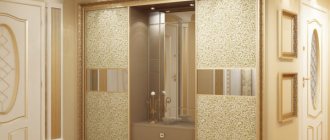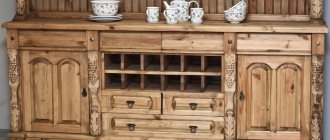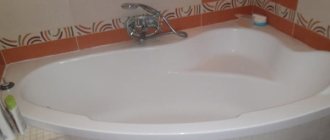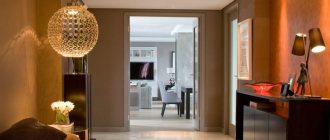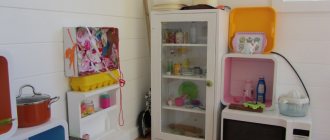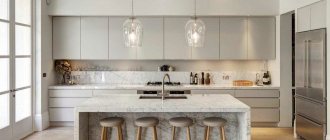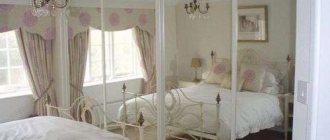Do-it-yourself wood brushing: 45 examples of using effective technology at home
Aged wood in bed design
Do-it-yourself wood brushing is one of the technologies for decorative finishing of wood products. The method is based on the difference in hardness of the layers that make up solid wood. The cross section clearly shows growth rings, which are formed by fibers with different physical characteristics.
In modern design, one of the fashionable materials used in the decoration of any premises is aged wood.
Loft-style bedroom with a wall trimmed with brushed wood
When the soft layer is removed, areas consisting of hard fibers become embossed, clearly appearing on the surface and giving the wood a particularly decorative appearance. Under natural conditions, this happens over time, when soft fibers are removed as the product is used. Brushing allows you to visually age the wood and give it texture in a carpentry workshop.
Kitchen sets with antique design
The main element of an antique kitchen interior is furniture. The production of kitchen sets now amazes with its diversity. But if you want solid wood furniture with all the attributes of natural aging, then you are unlikely to find it in your nearest store. Antique kitchen sets are made to order.
The main element of an antique kitchen interior is furniture.
Every self-respecting manufacturing company will provide you with several options to choose from, but the price of such a product will not be cheap. Most often, manufacturers offer furniture made of oak, but a more budget-friendly material is pine. Nowadays, a white antique kitchen is in great demand, which looks very organic in a modern interior. Thanks to the white color, your set will look very elegant even in a small room.
Nowadays, a white antique kitchen is in great demand, which looks very organic in a modern interior.
A separate topic is the countertop. It is made from solid wood or stone. Stone countertops are more durable and require little maintenance. A wooden tabletop can be matched to the facades of the set; with proper care, it can last quite a long time. The cheapest option is postforming material, which looks like natural wood and is very durable.
A wooden tabletop can be matched to the facades of the set; with proper care, it can last quite a long time.
The dining table and chairs should be chosen from wood; in retro style, forged elements in furniture are acceptable. The ideal option is if it is a set with a kitchen set.
The dining table and chairs should be chosen from wood; in retro style, forged elements in furniture are acceptable.
If you still have an old grandma's set in your house, don't rush to throw it away. You just need to restore it a little, and it will look great in retro style and delight you for many years.
If you still have an old grandma's set in your house, don't rush to throw it away
Antique furniture names terms and definitions
Bergere (French bergere) is a comfortable lounge chair with a reclined back, with armrests, completely upholstered in fabric. There is a pillow on the low seat. XVII century, Louis XV style.
Bureau (French bureau) is a type of desk with drawers, shelves and an advantageous work surface.
Wardrobe (English: wardrobe) – a wardrobe for clothes.
A cabinet is a cabinet product designed for storing expensive dishes, often with a glazed bay window and a mirrored back wall.
Dorzale (French demiule) is a choir bench in a monastery and church, intended for joint prayer, decorated with intarsia, tapestries, etc.
Dressoir (French: dressoir) – a shelf, a luxurious late Gothic sideboard with rich decoration and carvings, on the shelves of which expensive dishes were displayed. The number of shelves was regulated by the social position of the owner: the baron had two, the count had three, the prince had four, and high court officials had an additional canopy.
Zhidel – pidkvitnik, an antique table made of wood, for various purposes, may have a small back
Cabinet (French cabinet) – a luxurious and richly decorated cabinet for storing documents and valuables. The appearance of the office resembles a combination of a cabinet and a table. The cabinet has many drawers and partitions, closed by a door.
Canape (French canape) - a small sofa with a raised headboard, originated in France in the 18th century.
Department (Greek kathedra - chair, armchair) - in ancient times - the place from which rhetoricians and philosophers delivered speeches; elevation for a lecturer, teacher.
Credenz (fr. kredenz) – cupboard – buffet. In the 15th-16th centuries, it was a cabinet with a door on high legs, the lower part was open and was intended for storing large utensils - jugs, buckets, etc.
Voltaire's chair is the name of a lounge chair that has developed historically. Originally appeared in the 18th century. for the old and sickly French philosopher and writer Voltaire (1694–1778). Special features are a high backrest with support for the back of the head, which provides comfort during long-term sitting and the ability to sleep, similar to modern furniture for sitting in vehicles when traveling long distances (planes, trains).
A chaise longue is a light two-seater sofa designed for ease of conversation.
Console (French console) - a narrow wall table, often supported in front by one or two legs, was placed under a large mirror.
A desk is a type of desk for standing work, the working surface is tilted forward. For sitting at the desk, use a high stool with legs to support the legs (reminiscent of a bar stool).
Marquise (French marquise) – canopy, canopy, has many other meanings. Wide chair for two people to relax.
A bench is the simplest peasant bench - a board with four holes in which the legs are fixed.
A desk is a student's desk designed for educational institutions. It is a table structurally connected to a bench (at the bottom).
Psiche (French psiche) is a mirror that stands on stands on the floor or on a table and has a horizontal axis (at half its height) of rotation, which allows it to be tilted and this tilt fixed. In Ukraine they called him a psycho.
A console (lat. pulpitum - scaffold) is a table with an inclined working surface (tabletop), on which signal devices for controlling various processes are placed.
Music stand (French pupitre) – a stand for books, notes, etc. in the form of an inclined board mounted on a leg.
Sofa (tourist) – a low, wide sofa. The sofa has a low back on three sides (railings) and is designed to seat up to six people at the same time.
Stand (eng. stand) – a shield, a stand where the exhibits of the exhibition are located.
A bean table was primarily for needlework, the table top of which had an oval shape, reminiscent of a legume fruit, and was convenient to use.
Viennese chair is the historical name of a bent chair made of beech wood, a piece of variable circular cross-section obtained by turning. It was first made by Michael Thonet and was part of the furnishings of Viennese cafes. Became very popular from the middle of the 19th century. and has not left the market for more than 100 years. Now its silhouette is often imitated with plastic parts.
A stepladder chair is a chair that, when transformed, turns into a ladder. A very useful product in the kitchen, shops, libraries, etc.
Card table - after the name of the card game “ombre”, which has fallen into disuse. Its tabletop was covered with cloth and had double doors, which made it possible to double the working surface, opening it like a book.
The tabletop was secured to the tabletop with an axle bolt, which made it possible to rotate it horizontally, symmetrically orient it, and fix it relative to the tabletop when open. Now card tables are often designed for the kitchen or dining room (at home).
A chest is a medieval product (container), made of boards using carpentry, and could have a carved ornament. Featured in all styles until it was replaced with a wardrobe. It was used not only for its intended purpose, but also for sitting.
Step stool - see step stool.
A mattress, a hay box - a mattress, - a bag filled with hay, straw, etc. Now a frameless mattress, stuffed with sea grass or synthetic padding materials, quilted - a crib mattress.
The Slavic wardrobe (named after the manufacturer Slavyanov) is a combined wardrobe for dresses and linen. Distinctive features: wide doors with an external mirror and a bar behind them; behind a narrow door with a “window” of decorative composition (beveled glass) there is a compartment with shelves; Under each compartment there are external drawers at the bottom. The upper part of the product was completed with thick carved bars; beginning of the 19th century
The Swedish cabinet is a type of bookcase common in pre-revolutionary Russia, consisting of sections of a special design: the side walls of the bodies of each section were created from longitudinal bars; when installing sections on top of each other, the bars of one section filled the gaps between the bars of the second section. Characteristic is the opening of framed glazed doors: they were raised and thrust into the space above the books, held on by guides. Characteristic of the Scandinavian and Baltic countries.
Sharaga is a wall hanger mainly with several horizontal and vertical rows of hooks for storing clothes or small items; it could have a shelf at the top.
Chiffonier (French chifFonnier - chest of drawers) - a cabinet for storing linen and small items, equipped with pull-out shelves, drawers and half-shelves. Originated in France in the first half of the 17th century.
Scrinum (see chest) is a Latin word meaning closet.
Main features of an old-style room
This style involves the use of only natural materials.
- The ceiling is decorated with wooden beams. But if you have a small room, beams visually narrow the space, it is better to make a small imitation.
- The floor is made of natural parquet, planks or stone. It is permissible to lay linoleum with an imitation of natural material.
- Walls with a rough texture of light-colored decorative plaster. Kitchen apron made of stone or ceramic tiles to match the furniture.
The main thing is to harmoniously combine household appliances with an antique kitchen set and obligatory accessories in the old style. Manufacturers now offer household appliances stylized as wood; they will suit this style well.
The main thing is to harmoniously combine household appliances with an antique kitchen set and obligatory accessories in the old style.
You shouldn’t clutter your kitchen with everything you find at a flea market; a few things from years gone by will be enough to create an image of style and a cozy atmosphere.
You shouldn’t clutter your kitchen with everything you find at a flea market; a few things from years gone by will be enough to create an image of style and a cozy atmosphere.
Don’t forget about the presence of textiles in the kitchen - these are colorful curtains on the windows with floral and natural motifs, and bright rugs under your feet.
Don’t forget about the presence of textiles in the kitchen - these are colorful curtains on the windows with floral and natural motifs, and bright rugs under your feet.
Required Tools
To make furniture you need:
- measuring instruments;
- cutting and drilling tools (saws, knives, chisels, drills with drills, planes, clamps, crowns, wire cutters, screwdrivers, hammer);
- milling machine.
The materials you need are a primer, various stains, and varnish. When patination, you cannot do without acrylic paint and processing materials.
Kitchen decoration in retro style
This style is very diverse. You need to decide on the time period that you want to implement. A retro-style kitchen is characterized by restraint in form, practicality in furnishings and multifunctionality of things. Natural colors in the decoration can be combined with bright accents and metallic chrome parts in the interior.
A retro-style kitchen is characterized by restraint in form, practicality in furnishings and multifunctionality of things.
Basic design rules.
- The combination of natural materials is wood and metal, ceramics and glass.
- The bright color of the kitchen set will attract all the attention. Let’s assume a white kitchen set in this style, but then you need to add bright colors to the decoration.
- Regular geometric shapes in furniture and streamlined shapes of household appliances with large handles. Now manufacturers produce a lot of household appliances in the spirit of that time.
- When choosing a kitchen color scheme, you need to take into account the time period. The early period is characterized by monochrome colors with a play of tones. Later periods involve bright contrasts, floral motifs and natural patterns.
The decoration of the room in this style is very original.
- The walls are painted in a single color or covered with wallpaper with geometric shapes - checks, stripes or diamonds.
- This style welcomes a combination of many contrasting colors in the decoration. You can choose three or four contrasting colors and combine them in the room.
- The flooring in this style is a combination of red, white and black checkered colors on ceramic tiles. The use of stripes and other geometric shapes is acceptable. If you are not inclined to bright contrasts, then the floor can be made monochromatic.
- The ceiling should be simple. Plain plaster and matte white paint. You can add wooden beams, provided that the ceiling height allows it, otherwise they will create an oppressive atmosphere.
The main thing when implementing this style is properly selected lighting. A mandatory attribute is a simple round lampshade above the dining table and, in addition, a sconce and a floor lamp with a fabric lampshade.
The main thing when implementing this style is properly selected lighting.
Piece aging of wood
Let's start with the most practiced method - brushing. The whole process consists of running a hard metal brush over the treated wood, as a result of which the soft tissue of the wood is removed and its surface becomes embossed.
The first step is to take an ax and strike the surface of the material with its blunt side. The blows are delivered chaotically and with varying amounts of force. Then the top ball of soft fibers is removed using a stiff wire brush. The brush should be brushed along the fibers until the outline of seemingly natural temporary damage appears on the surface.
Then the skin is taken and the wood is sanded and further processed with a soft brush to remove fine fibers.
After the above steps, the material should be painted with stain or dark acrylic paint. After complete drying, using sandpaper, without much effort, remove the paint from the upper, protruding ridges, while the paint should remain in the potholes and cracks.
Finally, the material is coated with transparent varnish and allowed to dry.
The following methods do not require a rigid mechanical approach, but are accompanied by a number of rather dangerous operations. They cannot be carried out indoors.
Next up is firing. Here, using a blowtorch or burner, the wood to a depth of about 3 mm. Moreover, the deeper the firing, the more noticeable the aging effect will be. After firing the top layer, take a metal brush and scrape off the burnt parts until the desired effect is achieved.
Painting may not be used with this method. Afterwards the material is sanded and varnished.
The alkali method involves wetting the surface of the wood with chemicals containing alkali (this can be kitchen stove cleaners and other cleaning solutions). This substance eats away the soft fibers of the wood and paints it gray. Do-it-yourself puttying of walls for painting step by step?
Afterwards, the wood is covered with a layer of a weak solution of vinegar or citric acid (200 ml of water per 1 tsp). After drying, the product should be cleaned with a brush and, if necessary, painted.
Wood brushing is the artificial aging of wood. Colors: white base with gray highlights.
In this video we will show the finish of aged (brushed) wood, white with cinnamon streaks Ground.
Texturing tool. What are the best brushes to use? How to age a non-demountable door. Withdrawal.
Without special skills, without special and expensive tools, just a simple grinder and attachments. Brushing.
The first step is to take an ax and strike the surface of the material with its blunt side. The blows are delivered chaotically and with varying amounts of force. Then the top ball of soft fibers is removed using a stiff wire brush.
The brush should be brushed along the fibers until the outline of seemingly natural temporary damage appears on the surface. Then the skin is taken and the wood is sanded and further processed with a soft brush to remove fine fibers.
A more “humane” way. Suitable for small products and furniture, wooden dishes and other small surfaces. Brushing is done manually using a brush with metal bristles. In this case, as in the previous case, the soft fibers are removed, leaving ridges of hard wood. Use a hair brush to sweep away wood dust, monitoring the process by eye and achieving the desired degree of surface wear.
After this, the product is painted and decorated as indicated above.
- Subject the material to such an impact as a result of which the layers of wood will be destroyed, which, taking into account the heterogeneity of their physical characteristics, will lead to the appearance of a relief. Of course, this must be done in an accelerated mode compared to natural erosion;
- Give the surface a color similar to the change in natural color as a result of prolonged exposure to the environment. In other words, we must produce artificial patination.
Processing wood using the listed methods will help the owner to decorate the interior of the apartment in an antique style without investing a lot of money and without spending a lot of time on it. The availability of materials and tools for processing allows both an experienced carpenter and a beginner, and even a woman with imagination and skillful hands to engage in this type of creativity.
Step 4. When the relief begins to appear, the hand brush is replaced with an angle grinder with a metal brush, and work continues. The nozzle should be positioned perpendicular to the surface being treated, movements should be made strictly along the fibers. How to paint a wooden table with your own hands to look antique?
Sink and faucet in retro style
Plumbing products in this style are made of brass, copper and bronze with ceramic handles and valves. Manufacturers give their products the effect of metal oxidation to match the spirit of the times. The shapes are very varied, you can choose faucets stylized as an old telephone, tulip or bamboo.
Plumbing products in this style are made of brass, copper and bronze with ceramic handles and valves.
The faucets look like they are from the last century, but have all the functions of the latest plumbing fixtures. But in combination with a regular metal sink, such a faucet will look ridiculous. Therefore, it is better to buy sanitary ware complete with a sink made of natural stone or porcelain, then you will completely achieve the style in your kitchen.
The faucets look like they are from the last century, but have all the functions of the latest plumbing fixtures.
Carrying out vintage styles indoors is not an easy task. But knowing the basics of design and a sense of proportion in the use of accessories, you can easily cope with this task. And your kitchen will be original and unique.
Mechanical aging of wood
Drying, painting, and brushing are recommended to be done outdoors.
The most readily available materials for purchase are made from coniferous wood: pine, spruce, larch. They have a pronounced structure and pattern formed by fibers of different hardness. This makes them suitable for mechanical decoration.
Using tools that destroy the top layers of wood, you can achieve the effect of aging much faster than if it happened naturally. All abrasions, potholes and cracks can be imitated using 2 methods:
- Using a sharp corner of an ax, make holes of varying depths and widths in a chaotic manner on the surface of a board, beam or log. Bend the corners of the block a little with an axe, without worrying about neatness or a smooth surface. After this, all surfaces treated in this way must be thoroughly sanded with a stiff brush with steel bristles. When sanding a large product, it is better to use a drill or grinder with a special attachment. It is necessary to grind until all the sharp edges that appeared when chopping with an ax acquire the outlines of natural damage smoothed over time. It is important to remember that the movements of the brush should always be directed along the fibers. The next step will be sanding to remove protruding fibers and processing with a steel brush with softer bristles than the first time. This removes some of the soft fibers, creating shallow depressions between the ridges of the harder winter wood fibers. The same brush can additionally highlight knots and cracks.
- After sanding the light surface of the new product, you need to make it look like old wood that has darkened over time: paint it with stain or dark acrylic paint. After drying, using medium-grain sandpaper, without strong pressure, lightly rub the wood, removing paint from protruding ridges and hills. At the same time, the dark color remains in the potholes and between the fibers. For final finishing, the product is coated with acrylic transparent or light yellow varnish and dried until completely dry.
A more “humane” way. Suitable for small products and furniture, wooden dishes and other small surfaces. Brushing is done manually using a brush with metal bristles. In this case, as in the previous case, the soft fibers are removed, leaving ridges of hard wood. Use a hair brush to sweep away wood dust, monitoring the process by eye and achieving the desired degree of surface wear. After this, the product is painted and decorated as indicated above.
